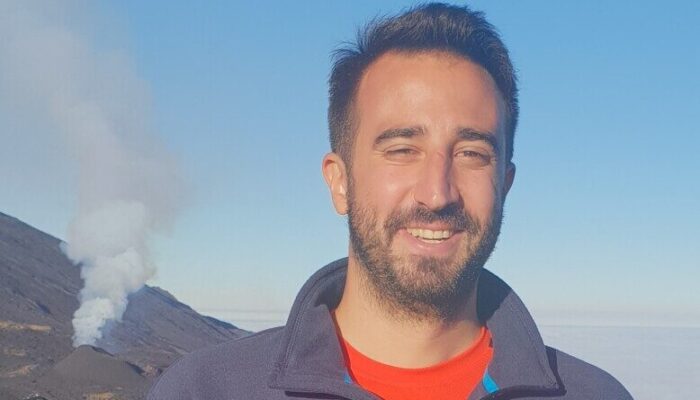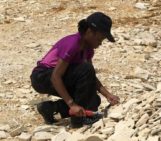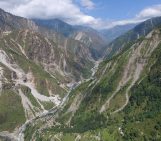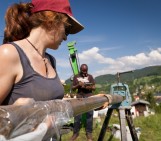
Hello Dinko. Thank you for agreeing to this interview! Before we dig deeper, could you tell our readers a little bit about yourself and your background?
Well thanks for having me. My name is Dinko and I’m a seismologist, doing a PostDoc at the Department of Geophysics at the University of Zagreb. Currently, I work on a Croatian-Norwegian collaboration project in which we densified seismic network in central Dalmatia, Croatia. The main objective of the project is to develop and modernise seismic hazard assessment in Croatia. My research is using machine learning to detect and locate earthquakes. As I said, in this project we densified the regional seismic network, the consequence of which is gathering more and more data to analyse, to better detect earthquakes and identify seismic phases, i.e. arrival of different phases of seismic waves. When you have just a few stations in a network, one person can easily do that, however when this network is made of a couple of tens of stations, the traditional approach can be very time consuming and it has to be done by multiple people. They all then bring their own biases in detecting the signals/signal characteristics so the idea that a machine does it with uniform uncertainty is quite appealing. I have a very good dataset from the Petrinja earthquake series as my case study, because the seismic network grew larger during this earthquake series.
While my current focus lies in tectonic seismology, my background is volcano seismology. During my PhD I conducted research on the very-long period seismic signals on volcanoes – very interesting, understudied seismic signals on volcanoes – which offer us unique insights into the complex dynamics occurring within volcanoes.
What is a seismic signal, and how can they tell us what’s happening beneath our feet?
When an earthquake happens it releases energy which then propagates through Earth’s subsurface as seismic waves and they are detected and recorded by instruments called seismometers. It is not just earthquakes that generate seismic signals, their cause can be other natural events like volcanic activity, landslides, and even wind. Human activities such as underground nuclear tests, controlled explosions, and even jumping can also produce seismic signals.
By studying seismic signals, we can gain insights into the Earth’s interior structure, fault systems, and the dynamics of earthquakes, which can be used for earthquake monitoring, hazard assessment, and understanding tectonic processes.
I mentioned here how underground nuclear tests generate seismic signals. During the height of nuclear testing in the 1950s and 1960s, the best way to see what the “other side” was doing was by placing seismometers and analysing seismic data because (large) explosions have a distinct seismic signature. Seismologists realised that the seismic waves generated by these underground nuclear tests could provide valuable information about the Earth’s interior. By studying the characteristics of the seismic waves as they travelled through the Earth, they were able to infer details about the composition, density, and structure of the different layers within our planet. In particular, the analysis of seismic waves from nuclear explosions helped in the development of the discipline known as “seismic tomography.” Similar to CT (computerised tomography) scans of a human body, we can create three-dimensional images of the Earth’s interior using seismic tomography. By comparing the arrival times and amplitudes of seismic waves generated by these explosions at different seismic stations, seismologists were able to map the distribution of seismic velocities and infer the presence of different rock types and structures at various depths.
Of course today, luckily, we do not have nuclear testing anymore, so we use seismic data from earthquakes for our tomography studies. But earthquakes are quite tricky, you can’t predict them, even when you have an idea in what area they are most likely to happen, you still can’t predict the size of the next one. Therefore, seismologists thought of how to make use of the continuous noise our instruments record – the ambient noise. Seismic ambient noise refers to the continuous vibrations or waves that are present in the Earth’s crust, generated by various sources such as ocean waves, wind, traffic, and human activities. By analysing the variations in the arrival times and characteristics of the ambient noise waves at different seismic stations, researchers can create high-resolution images of the subsurface, revealing information about the velocity and attenuation properties of the rocks and sediments beneath the Earth’s surface. This non-invasive method has gained popularity in geophysics and has provided valuable insights into the geological and tectonic features of regions around the world.
The use of seismic signals has not only helped us understand our own planet but has also expanded to other celestial bodies. By placing seismometers on the Moon and Mars, we hope to unravel the intriguing secrets of these celestial bodies. Exploring seismic signals is a powerful tool for unlocking the mysteries of our planet and potentially discovering new insights about other worlds.
From magma flow to earthquakes, there’s a lot happening in the depths of our planet. What makes a signal unique, interesting, or worthy of scrutiny compared to other noise?
I think an example from volcano seismology can answer this question best. Volcanoes are quite complex environments, we have magma intrusions, magmatic gases, or in hydrothermal environments we can have shallow reservoirs of steam or hot water, and they all individually, let alone all together, make their seismic signature unique and interesting. The seismic signals we observe on our stations most commonly are distinguished by their frequency content and are classified in different categories. The two main ones are called high-frequency, or volcano-tectonic (VT) earthquakes and low-frequency or long-period events. The occurrence of each of these signals tells its own story – the VT earthquakes do not differ much from “regular”, tectonic earthquakes as they are generated by the brittle failure of rocks due to the stress changes of magmatic emplacement. By locating their hypocentres we can map the emplacement or withdrawal of fresh magma. On the other hand, the long-period signals, which often occur in seismic swarms of repetitive signals with very similar waveforms, are linked to the magma ascent and therefore are used as a potential forecasting tool for volcano eruptions. Then you have very-long period (VLP) seismic signals that can be caused by mass movements of magmatic fluids in the volcanic edifice, or changes to the geometry of the volcanic plumbing system, rockfall and landslides as well have their own “seismic signature”. This means that:
It is crucial to monitor and correctly classify observed seismic signals as they help us infer what is happening inside this complex system and report our findings to policymakers and public.
This was just a simplified example from volcano seismology, but each seismic signal, whatever its origin is, carries valuable information about the structure of the subsurface through which the seismic wave propagates. By accurately locating the origins of a seismic wave, revealing the mechanism by which an earthquake occurs, and inferring the properties of the medium through which it propagates, we can effectively mitigate seismic risk and minimise potential hazards.
And as I said before, don’t be too harsh on the noise, it is still a valuable signal 🙂
You’re also the Early Career Scientist Representative for the EGU Seismology Division. Could you tell us more about what you do and how people can get involved?
Of course! As the Early Career Scientist (ECS) Representative for the EGU Seismology Division, I represent the voices of early career scientists in our community. Our team consists of young researchers from various European institutions, and we actively communicate the thoughts, ideas, and challenges of our community with others within the EGU, ensuring that the perspectives of early career seismologists are represented and taken into account.
We not only advocate for early career seismologists, but also provide valuable resources. Our Job Portal collects advertised positions, making it easier for ECS to find research opportunities. We also publish blog posts written either by our team or guest writers on recent seismic events (our Earthquake Watch blog series) and experiments/fieldworks (our SENSOR blog series).
During the EGU General Assembly, we organise networking social events and offer a Seismology 101 course for newcomers and non-seismologists.
If you’re interested in getting involved, feel free to email us at ecs-sm@egu.eu or follow us on IG (@egu_seismo), Twitter (@EGU_seismo), and Facebook (EGU Seismology Division). We’re always open to new people, ideas, and participation from early career seismologists.
Finally, what are you looking forward to in the future?
Funny you asked as my job contract is nearing its end; I hope to find a new position somewhere soon. I always say that working in research/academia is the best job one might have so hopefully I will be able to continue with it.




